What We’re Reading: April 14
Note: Read Why We’re Writing “What We’re Reading”
Review: Ion transport at the vacuole during stomatal movement
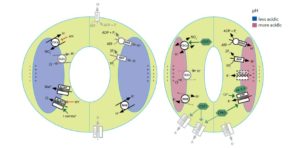 Gas exchange and transpiration are regulated by the stomatal aperture, which is itself regulated by the changes in volume of the guard cells that overlie the stomatal pore. When triggered to open, solutes such as K+ and Cl– enter the guard cell through ion transporters, followed osmotically by water; as the cells enlarge, the gap between them widens permitting gas and water vapour transit. Ion transporters at the guard cell plasma membrane are more accessible for patch clamping, and in recent years our knowledge of these essential transporters has increased dramatically. However, ultimately it is the movement of ions and water into the vacuole that controls stomatal aperture, and our understanding of the tonoplast (vacuolar membrane) transporters lags behind those of the plasma membrane. Eisenach and De Angeli review ion transport at the guard cell vacuole, drawing on electrophysiological studies and results from Arabidopsis genetics, and discussing the contributions of vacuolar pH and membrane potential to stomatal movement. Plant Physiol. 10.1104/pp.17.00130 Tags: Cell Biology, Transport
Gas exchange and transpiration are regulated by the stomatal aperture, which is itself regulated by the changes in volume of the guard cells that overlie the stomatal pore. When triggered to open, solutes such as K+ and Cl– enter the guard cell through ion transporters, followed osmotically by water; as the cells enlarge, the gap between them widens permitting gas and water vapour transit. Ion transporters at the guard cell plasma membrane are more accessible for patch clamping, and in recent years our knowledge of these essential transporters has increased dramatically. However, ultimately it is the movement of ions and water into the vacuole that controls stomatal aperture, and our understanding of the tonoplast (vacuolar membrane) transporters lags behind those of the plasma membrane. Eisenach and De Angeli review ion transport at the guard cell vacuole, drawing on electrophysiological studies and results from Arabidopsis genetics, and discussing the contributions of vacuolar pH and membrane potential to stomatal movement. Plant Physiol. 10.1104/pp.17.00130 Tags: Cell Biology, Transport
Review: Bound by fate: Reactive oxygen species in receptor-like kinase signaling
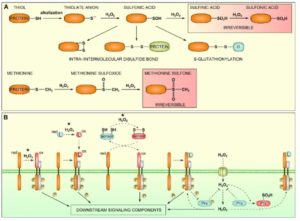 Both receptor-like protein kinase (RLK) and reactive oxygen species (ROS) signaling have been shown to affect a plethora of plant processes, including growth, metabolism, development, and environmental responses. To date, previous reviews have focused on mechanisms that govern either ROS or RLK signaling; however, Kimura et al. examined mechanisms that govern cross-talk between ROS and RLK and demonstrate ways in which RLKs both influence and are influenced by ROS signaling. Several key factors and a variety of biological contexts that they function in are considered within the context of receptor-mediated redox signaling in response to extra- and intra-cellular cues. (Summary by Tyra McCray) Plant Cell 10.1105/tpc.16.00947 Tags: Biotic Interactions, Cell Biology, Signals and Responses
Both receptor-like protein kinase (RLK) and reactive oxygen species (ROS) signaling have been shown to affect a plethora of plant processes, including growth, metabolism, development, and environmental responses. To date, previous reviews have focused on mechanisms that govern either ROS or RLK signaling; however, Kimura et al. examined mechanisms that govern cross-talk between ROS and RLK and demonstrate ways in which RLKs both influence and are influenced by ROS signaling. Several key factors and a variety of biological contexts that they function in are considered within the context of receptor-mediated redox signaling in response to extra- and intra-cellular cues. (Summary by Tyra McCray) Plant Cell 10.1105/tpc.16.00947 Tags: Biotic Interactions, Cell Biology, Signals and Responses
Review: Arsenic transport in rice and biological solutions to reduce risk
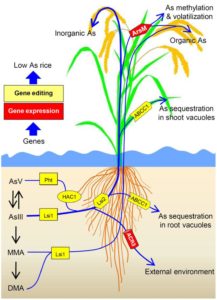 Rice is a staple food for half of the world’s population, but it accumulates the toxic metalloid arsenic (As), which is present in soils and in plants in two forms, arsenate (AsV) and arsenite (AsIII). Chen et al. review the genetics and biochemistry of As uptake and sequestration into the rice grain, including a discussion of transporters, As efflux, volatilization and sequestration. The identification of these processes has supported studies to knockout or overexpress genes that can limit As acccumulation in the grain. These candidate genes can then be targeted for modification by gene editing or selective breeding to address the serious public health consequences of arsenic in rice. Front. Plant Sci. 10.3389/fpls.2017.00268 Tags: Applied Plant Biology, Biochemistry, Transport
Rice is a staple food for half of the world’s population, but it accumulates the toxic metalloid arsenic (As), which is present in soils and in plants in two forms, arsenate (AsV) and arsenite (AsIII). Chen et al. review the genetics and biochemistry of As uptake and sequestration into the rice grain, including a discussion of transporters, As efflux, volatilization and sequestration. The identification of these processes has supported studies to knockout or overexpress genes that can limit As acccumulation in the grain. These candidate genes can then be targeted for modification by gene editing or selective breeding to address the serious public health consequences of arsenic in rice. Front. Plant Sci. 10.3389/fpls.2017.00268 Tags: Applied Plant Biology, Biochemistry, Transport
Review: Insights into plant adaptation from transcriptomics and proteomics studies
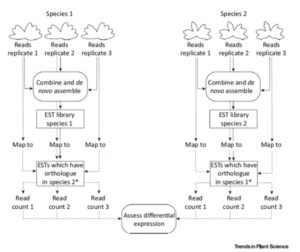 Omics approaches have helped shed light on how plants relate to their environment and how they respond to changes in it. Although still relatively underutilized, comparative transcriptomics and proteomics approaches also can be applied to study mechanisms of plant adaptation. Voelckel et al. discuss the pros and cons of using omics approaches to study adaptability, from differential expression of key genes between closely related species, to proteome studies giving insights into post-translational modifications, protein location, protein turnover, etc. Integrating phenotypic, proteomic, transcriptomic and environmental data can identify genes underlying the expression of adaptive traits. (Summary by Gaby Auge) Trends Plant Sci. 10.1016/j.tplants.2017.03.001 Tags: Evolution, Genomics
Omics approaches have helped shed light on how plants relate to their environment and how they respond to changes in it. Although still relatively underutilized, comparative transcriptomics and proteomics approaches also can be applied to study mechanisms of plant adaptation. Voelckel et al. discuss the pros and cons of using omics approaches to study adaptability, from differential expression of key genes between closely related species, to proteome studies giving insights into post-translational modifications, protein location, protein turnover, etc. Integrating phenotypic, proteomic, transcriptomic and environmental data can identify genes underlying the expression of adaptive traits. (Summary by Gaby Auge) Trends Plant Sci. 10.1016/j.tplants.2017.03.001 Tags: Evolution, Genomics
Review: Ancient plant DNA in lake sediments
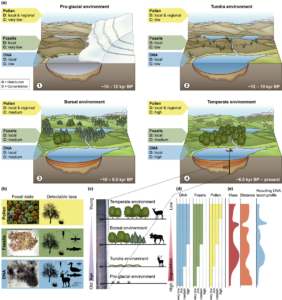 Fossils have been extremely useful in efforts to reconstruct the past, but recently the analysis of ancient DNA (aDNA) has taken off. Parducci et al. describe the value of lake sediments as sources of ancient DNA from which to gain insights into the plant populations of ancient times. Lakes are found all over the world, collect DNA from large areas, and retain the DNA in age-correlated layers. Sources of aDNA in sediments, best practices for handling sediment samples to avoid contamination, and bioinformatics tools are discussed. New Phytol. 10.1111/nph.14470 Tags: Ecophysiology, Environmental Plant Biology, Evolution
Fossils have been extremely useful in efforts to reconstruct the past, but recently the analysis of ancient DNA (aDNA) has taken off. Parducci et al. describe the value of lake sediments as sources of ancient DNA from which to gain insights into the plant populations of ancient times. Lakes are found all over the world, collect DNA from large areas, and retain the DNA in age-correlated layers. Sources of aDNA in sediments, best practices for handling sediment samples to avoid contamination, and bioinformatics tools are discussed. New Phytol. 10.1111/nph.14470 Tags: Ecophysiology, Environmental Plant Biology, Evolution
Special issue: Flowering of jasmonate research
 Jasmonates are a family of compounds including jasmonic acid and its derivatives that regulate many plant processes from germination to defense. The Journal of Experimental Botany has a special issue on jasmonate research, which commemorates the advances in this field in the ten years since the JAZ proteins were identified. The open access editorial overview by Zhu and Napier (10.1093/jxb/erx068) provides an excellent overview of this topic that is well worth reading. Several additional review articles cover the jasmonates from signaling to transcriptional responses to their roles in development and defense. J. Exp. Bot. Tags: Biochemistry, Development, Gene Regulation, Growth Regulation, Molecular Biology, Signals and Responses
Jasmonates are a family of compounds including jasmonic acid and its derivatives that regulate many plant processes from germination to defense. The Journal of Experimental Botany has a special issue on jasmonate research, which commemorates the advances in this field in the ten years since the JAZ proteins were identified. The open access editorial overview by Zhu and Napier (10.1093/jxb/erx068) provides an excellent overview of this topic that is well worth reading. Several additional review articles cover the jasmonates from signaling to transcriptional responses to their roles in development and defense. J. Exp. Bot. Tags: Biochemistry, Development, Gene Regulation, Growth Regulation, Molecular Biology, Signals and Responses
Cell-free membrane protein expression system enables functional characterization of receptor-like protein kinase FERONIA ($)
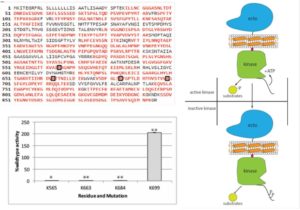 Membrane proteins are some of the most interesting cellular proteins, serving as sensors and transducers of diverse signals, yet they also are the most challenging to investigate because they require lipid interactions for proper structure and function. Recently, cell-free expression systems for membrane proteins have been developed that incorporate lipid nanodiscs consisting of membrane scaffold proteins (MSPs, derived from apolipoproteins) that wrap around a patch of phospholipid bilayer. FERONIA is a plant receptor-like kinase and part of a very large but not well characterized family of membrane proteins. By co-expressing FERONIA in a cell-free expression system with MSP and lipids, Minkoff et al. were able to characterize it functionally in vitro, including assaying the kinase activity of various point mutations for comparison to predictions from molecular genetic studies. This work also demonstrates the applicability of this expression system for the study of plant receptor-like kinases. J. Biol. Chem. 10.1074/jbc.M116.761981 Tags: Biochemistry, Signals and Responses
Membrane proteins are some of the most interesting cellular proteins, serving as sensors and transducers of diverse signals, yet they also are the most challenging to investigate because they require lipid interactions for proper structure and function. Recently, cell-free expression systems for membrane proteins have been developed that incorporate lipid nanodiscs consisting of membrane scaffold proteins (MSPs, derived from apolipoproteins) that wrap around a patch of phospholipid bilayer. FERONIA is a plant receptor-like kinase and part of a very large but not well characterized family of membrane proteins. By co-expressing FERONIA in a cell-free expression system with MSP and lipids, Minkoff et al. were able to characterize it functionally in vitro, including assaying the kinase activity of various point mutations for comparison to predictions from molecular genetic studies. This work also demonstrates the applicability of this expression system for the study of plant receptor-like kinases. J. Biol. Chem. 10.1074/jbc.M116.761981 Tags: Biochemistry, Signals and Responses
Intron DNA sequences can be more important than the proximal promoter in determining the site of transcript initiation
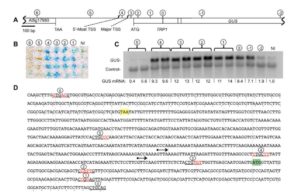 The site at which transcription begins is traditionally thought to be determined in the proximal promoter by assembly of the pre-initiation complex just upstream of the transcription start site (TSS). New results from Gallegos and Rose challenge this assumption. Prior studies have shown that the presence of an intron near the TSS can boost transcript levels, an effect known as intron-mediated enhancement (IME). While exploring the constraints of intron position on IME, the authors found that in some conditions introns can change the location of the TSS and substitute for a missing proximal promoter. The mechanism of these effects is not clear, but the authors specture it may involve the formation of a region of open DNA that enables access by the transcriptional machinery. Plant Cell 10.1105/tpc.17.00020 Tags: Gene Regulation, Molecular Biology
The site at which transcription begins is traditionally thought to be determined in the proximal promoter by assembly of the pre-initiation complex just upstream of the transcription start site (TSS). New results from Gallegos and Rose challenge this assumption. Prior studies have shown that the presence of an intron near the TSS can boost transcript levels, an effect known as intron-mediated enhancement (IME). While exploring the constraints of intron position on IME, the authors found that in some conditions introns can change the location of the TSS and substitute for a missing proximal promoter. The mechanism of these effects is not clear, but the authors specture it may involve the formation of a region of open DNA that enables access by the transcriptional machinery. Plant Cell 10.1105/tpc.17.00020 Tags: Gene Regulation, Molecular Biology
Light sheet fluorescence microscopy quantifies calcium oscillations in root hairs
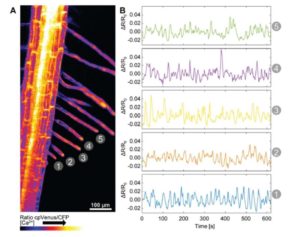 Light sheet fluorescence microscopy (LSFM) is a powerful imaging tool; unlike confocal microscopy, which illuminates a sample one small volume at a time, LSFM illuminates a complete optical section at a time, greatly speeding up the imaging process and lowering phototoxic effects. Candeo et al. use close-to-physiological imaging of tip-growing root hairs through the combination of LSFM with the Yellow Chameleon YC3.6 reporter, which provides a sensitive readout for calcium and can be used to record calcium oscillations in the root hair. The authors recorded both low- and high-frequency calcium oscillations, and showed a correlation between the high-frequency oscillations and the pulsatile behaviour of root hair growth. Plant Cell Physiol. 10.1093/pcp/pcx045 Tags: Cell Biology, Growth Regulation
Light sheet fluorescence microscopy (LSFM) is a powerful imaging tool; unlike confocal microscopy, which illuminates a sample one small volume at a time, LSFM illuminates a complete optical section at a time, greatly speeding up the imaging process and lowering phototoxic effects. Candeo et al. use close-to-physiological imaging of tip-growing root hairs through the combination of LSFM with the Yellow Chameleon YC3.6 reporter, which provides a sensitive readout for calcium and can be used to record calcium oscillations in the root hair. The authors recorded both low- and high-frequency calcium oscillations, and showed a correlation between the high-frequency oscillations and the pulsatile behaviour of root hair growth. Plant Cell Physiol. 10.1093/pcp/pcx045 Tags: Cell Biology, Growth Regulation
Phosphatidylinositol 3-phosphate–binding protein AtPH1 controls the localization of the metal transporter NRAMP1
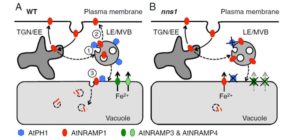 NRAMPs are transporters of iron (Fe) and manganese (Mn). The nramp3nramp4 double mutant arrests shortly after germination, due to its inability to remobilize Fe from seed vacuolar stores. Agorio et al. used a genetic approach to identify nns1, a partial suppressor of the growth-arrest phenotype. They mapped nns1 to AtPH1, a gene encoding a pleckstrin-homology (PH) domain protein. The PH domain binds the membrane lipid phosphatidylinositol 3-phosphate (PI3P) – PI3P and other phosphorylated PIs are known to specifically recruit proteins to membrane subdomains. In the nns1 mutant that lacks AtPH1, NRAMP1 (normally found in the endosomal pathway and at the plasma membrane) is mislocalized to the vacuole, where it is thought to complement the missing iron transport function of the nramp3nramp4 mutant. Proc. Natl. Acad. Sci. USA 10.1073/pnas.1702975114 Tags: Cell Biology, Genetics, Transport
NRAMPs are transporters of iron (Fe) and manganese (Mn). The nramp3nramp4 double mutant arrests shortly after germination, due to its inability to remobilize Fe from seed vacuolar stores. Agorio et al. used a genetic approach to identify nns1, a partial suppressor of the growth-arrest phenotype. They mapped nns1 to AtPH1, a gene encoding a pleckstrin-homology (PH) domain protein. The PH domain binds the membrane lipid phosphatidylinositol 3-phosphate (PI3P) – PI3P and other phosphorylated PIs are known to specifically recruit proteins to membrane subdomains. In the nns1 mutant that lacks AtPH1, NRAMP1 (normally found in the endosomal pathway and at the plasma membrane) is mislocalized to the vacuole, where it is thought to complement the missing iron transport function of the nramp3nramp4 mutant. Proc. Natl. Acad. Sci. USA 10.1073/pnas.1702975114 Tags: Cell Biology, Genetics, Transport
Transcription factor interplay between LEAFY and APETALA1/ CAULIFLOWER during floral initiation
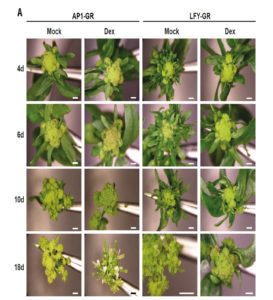 Several transcription-factor encoding genes involved in the transition from vegetative to reproductive growth have been identified. One of these, LEAFY (LFY), is expressed at the flanks of the inflorescence meristem at the site of newly forming floral meristems; loss-of-function lfy mutants produce leaves instead of flowers. APETALA1 (AP1) and CAULIFLOWER (CAL) are related genes expressed very early in floral meristem development; loss-of-function of both genes leads to an overproliferation of inflorescence meristem tissue, forming an apex that resembles a cauliflower. Goslin et al. looked at gene expression in a plant in which LFY was activated by fusion to the glucocorticoid receptor (LFY-GR) in an ap1/cal mutant background. Specific LFY targets in the mutant and wild-type background were compared, and compared to results from an AP1-GR study, to examine the regulatory interplay between these transcription factors. Although both genetic and molecular evidence suggest that LFY and AP1/CAL act in a partially redundant manner in floral meristem specification, some of their gene targets show antagonistic regulation. The authors suggest a model in which LFY and AP1/CAL form an incoherent feedback loop; “by providing positive as well as negative inputs, LFY might ensure that flower development can commence only when AP1/CAL levels are sufficiently high to efficiently activate the expression of other key floral regulators.” Plant Physiol. 10.1104/pp.17.00098 Tags: Development, Gene Regulation, Genetics, Systems Biology
Several transcription-factor encoding genes involved in the transition from vegetative to reproductive growth have been identified. One of these, LEAFY (LFY), is expressed at the flanks of the inflorescence meristem at the site of newly forming floral meristems; loss-of-function lfy mutants produce leaves instead of flowers. APETALA1 (AP1) and CAULIFLOWER (CAL) are related genes expressed very early in floral meristem development; loss-of-function of both genes leads to an overproliferation of inflorescence meristem tissue, forming an apex that resembles a cauliflower. Goslin et al. looked at gene expression in a plant in which LFY was activated by fusion to the glucocorticoid receptor (LFY-GR) in an ap1/cal mutant background. Specific LFY targets in the mutant and wild-type background were compared, and compared to results from an AP1-GR study, to examine the regulatory interplay between these transcription factors. Although both genetic and molecular evidence suggest that LFY and AP1/CAL act in a partially redundant manner in floral meristem specification, some of their gene targets show antagonistic regulation. The authors suggest a model in which LFY and AP1/CAL form an incoherent feedback loop; “by providing positive as well as negative inputs, LFY might ensure that flower development can commence only when AP1/CAL levels are sufficiently high to efficiently activate the expression of other key floral regulators.” Plant Physiol. 10.1104/pp.17.00098 Tags: Development, Gene Regulation, Genetics, Systems Biology
KNOTTED1 cofactors, BLH12 and BLH14, regulate internode patterning and vein anastomosis in maize
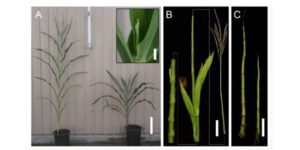 The maize shoot comprises modular domains of leaf, subtending shoot tissue, and an intercalary meristem that sits just above the next leaf down. By contrast to eudicot shoots that form a ring of vascular bundles, maize shoot vascular bundles remain as separate bundles, forming a “disordered” atactostele. Tsuda et al. used a reverse-genetic approach to investigate the function of BELL1-like Homeobox (BLH) transcription factors in maize, and focused on two that are highly expressed in the shoot meristem, BLH12 and BLH14. Both proteins interact in vivo and in vitro with the KN1 transcription factor. The double mutant blh12/14 was much shorter than its siblings and showed a premature differentiation of the intercalary meristem. Furthermore, in the double mutant vascular bundle number was significantly reduced due to both a decrease in their formation and an increase on their tendency to merge together (anastamose). This study then shows a role for BLH12 and BLH14 in preventing vein fusion, contributing to the maintenance of distinct vascular bundles in maize, and in preventing premature differentiation of the intercalary meristem. Plant Cell 10.1105/tpc.16.00967 Tags: Development, Gene Expression
The maize shoot comprises modular domains of leaf, subtending shoot tissue, and an intercalary meristem that sits just above the next leaf down. By contrast to eudicot shoots that form a ring of vascular bundles, maize shoot vascular bundles remain as separate bundles, forming a “disordered” atactostele. Tsuda et al. used a reverse-genetic approach to investigate the function of BELL1-like Homeobox (BLH) transcription factors in maize, and focused on two that are highly expressed in the shoot meristem, BLH12 and BLH14. Both proteins interact in vivo and in vitro with the KN1 transcription factor. The double mutant blh12/14 was much shorter than its siblings and showed a premature differentiation of the intercalary meristem. Furthermore, in the double mutant vascular bundle number was significantly reduced due to both a decrease in their formation and an increase on their tendency to merge together (anastamose). This study then shows a role for BLH12 and BLH14 in preventing vein fusion, contributing to the maintenance of distinct vascular bundles in maize, and in preventing premature differentiation of the intercalary meristem. Plant Cell 10.1105/tpc.16.00967 Tags: Development, Gene Expression
Strigolactone- and karrikin-independent SMXL proteins are central regulators of phloem formation
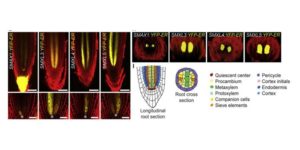 SMAX1 (SUPPRESSOR OF MAX2 1) was identified genetically as a suppressor of the enhanced seed dormancy phenotype of the max2 mutant, which is affected in both strigolactone (SL) and karrikin (KAR) responses (karrikins are smoke-derived germination promoters). SMAX1 is the founding member of an eight-member gene family in Arabidopsis, the SMAX1-LIKE family (SMXL); the encoded proteins show weak homology to HEAT SHOCK PROTEIN 101. Wallner et al. investigated the function of previously uncharacterized SMXL3, 4 and 5, through single mutants, double mutant combinations, and the triple mutant. The single mutants showed no abnormal phenotype, but all double mutants and the triple mutant showed reduced root growth. The genes are expressed in the protophloem, promote phloem development, and do not depend on SL or KAR signalling components. Curr. Biol. 10.1016/j.cub.2017.03.014 Tags: Development, Gene Regulation, Signals and Responses
SMAX1 (SUPPRESSOR OF MAX2 1) was identified genetically as a suppressor of the enhanced seed dormancy phenotype of the max2 mutant, which is affected in both strigolactone (SL) and karrikin (KAR) responses (karrikins are smoke-derived germination promoters). SMAX1 is the founding member of an eight-member gene family in Arabidopsis, the SMAX1-LIKE family (SMXL); the encoded proteins show weak homology to HEAT SHOCK PROTEIN 101. Wallner et al. investigated the function of previously uncharacterized SMXL3, 4 and 5, through single mutants, double mutant combinations, and the triple mutant. The single mutants showed no abnormal phenotype, but all double mutants and the triple mutant showed reduced root growth. The genes are expressed in the protophloem, promote phloem development, and do not depend on SL or KAR signalling components. Curr. Biol. 10.1016/j.cub.2017.03.014 Tags: Development, Gene Regulation, Signals and Responses
MtLAX2, a functional homologue of the auxin influx transporter AUX1, is required for nodule organogenesis
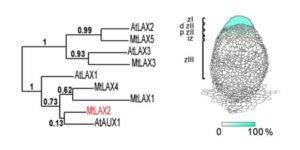 Nodules are specialized structures that form symbiotic, nitrogen-fixing associations with rhizobia on some plants including Medicago truncatula. Previous work has shown that auxin signalling is involved in nodule formation. Roy et al. extend this knowledge through the identification of a Medicago gene encoding MtLAX2 that is a functional homologue of the Arabidopsis auxin influx transporter AUX1. Loss of function mutants mtlax2 and aux1 show similar phenotypes including reduced sensitivity to auxin, reduced lateral root number, and reduced root gravitropism. Furthermore, MtLAX2 is expressed at very early stages of nodule formation and is required for nodule initiation. This study indicates that auxin influx is crucial for both nodule and lateral root organogenesis, and provides additional insights into the process of nodule formation. Plant Physiol. 10.1104/pp.16.01473 Tags: Development, Signals and Responses, Transport
Nodules are specialized structures that form symbiotic, nitrogen-fixing associations with rhizobia on some plants including Medicago truncatula. Previous work has shown that auxin signalling is involved in nodule formation. Roy et al. extend this knowledge through the identification of a Medicago gene encoding MtLAX2 that is a functional homologue of the Arabidopsis auxin influx transporter AUX1. Loss of function mutants mtlax2 and aux1 show similar phenotypes including reduced sensitivity to auxin, reduced lateral root number, and reduced root gravitropism. Furthermore, MtLAX2 is expressed at very early stages of nodule formation and is required for nodule initiation. This study indicates that auxin influx is crucial for both nodule and lateral root organogenesis, and provides additional insights into the process of nodule formation. Plant Physiol. 10.1104/pp.16.01473 Tags: Development, Signals and Responses, Transport
Signatures of adaptation in the weedy rice genome
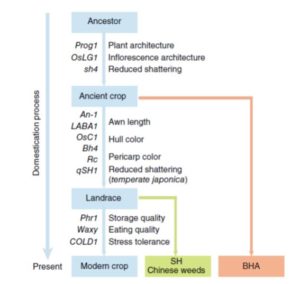 Crop domestication has been accompanied by the evolution of aggressive weedy crop relatives that compete for resources and make weed management a challenge. By using whole-genome sequencing of the two most commonly found weedy rice strains in the US (SH and BHA), and comparing them with the genomes of several accessions of cultivated rice, wild progenitors and other weedy strains from China, Li et al. aimed to shed light on the genetic mechanisms underlying the evolution of weedy rice. The authors found that US weedy rice strains originated from Asian accessions after the domestication of rice in Asia, finding support for the de-domestication hypothesis due to the presence of certain early-selected domestication-associated alleles. Moreover, they found that weediness can apparently evolve relatively easily, through selection on a small number of genomic regions. These findings should be a warning to rice producers around the world to stay vigilant to the presence of weedy strains. (Summary by Gaby Auge) Nature Genet. 10.1038/ng.3825 (Note – if you like stories about rice domestication, a related paper by Wang et al. looking at evidence of selective sweeps and feralization in the genomes of Asian wild rice has just come out in Genome Research ). Tags: Applied Plant Biology, Evolution, Genetics, Genomics
Crop domestication has been accompanied by the evolution of aggressive weedy crop relatives that compete for resources and make weed management a challenge. By using whole-genome sequencing of the two most commonly found weedy rice strains in the US (SH and BHA), and comparing them with the genomes of several accessions of cultivated rice, wild progenitors and other weedy strains from China, Li et al. aimed to shed light on the genetic mechanisms underlying the evolution of weedy rice. The authors found that US weedy rice strains originated from Asian accessions after the domestication of rice in Asia, finding support for the de-domestication hypothesis due to the presence of certain early-selected domestication-associated alleles. Moreover, they found that weediness can apparently evolve relatively easily, through selection on a small number of genomic regions. These findings should be a warning to rice producers around the world to stay vigilant to the presence of weedy strains. (Summary by Gaby Auge) Nature Genet. 10.1038/ng.3825 (Note – if you like stories about rice domestication, a related paper by Wang et al. looking at evidence of selective sweeps and feralization in the genomes of Asian wild rice has just come out in Genome Research ). Tags: Applied Plant Biology, Evolution, Genetics, Genomics
CrowdCurio: an online crowdsourcing platform for climate change studies using herbarium specimens ($)
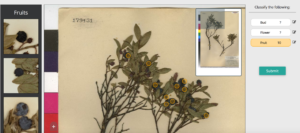 Crowdsourcing leverages the inputs, ideas and talents of many people in parallel to achieve a goal. Crowdsourcing or “citizen science” can also be an effective approach for science outreach that engages the public by enabling them to collect and analyze data. Willis et al. have developed and assessed a crowdsourced project in which digitized herbaria specimens were evaluated to generate a phenology database. Specifically, specimens of two species collected across 200 years were analyzed for the numbers of flower buds, flowers and fruits, to investigate changes in the timing of flowering. The authors found no differences in the quality of the data collected by experts and non-experts, demonstrating the feasibility of this approach. The project lives on the portal CrowdCurio, and is called Thoreau’s Field Notes. New Phytol. 10.1111/nph.14535 Tags: Ecophysiology, Education and Outreach
Crowdsourcing leverages the inputs, ideas and talents of many people in parallel to achieve a goal. Crowdsourcing or “citizen science” can also be an effective approach for science outreach that engages the public by enabling them to collect and analyze data. Willis et al. have developed and assessed a crowdsourced project in which digitized herbaria specimens were evaluated to generate a phenology database. Specifically, specimens of two species collected across 200 years were analyzed for the numbers of flower buds, flowers and fruits, to investigate changes in the timing of flowering. The authors found no differences in the quality of the data collected by experts and non-experts, demonstrating the feasibility of this approach. The project lives on the portal CrowdCurio, and is called Thoreau’s Field Notes. New Phytol. 10.1111/nph.14535 Tags: Ecophysiology, Education and Outreach




Leave a Reply
Want to join the discussion?Feel free to contribute!